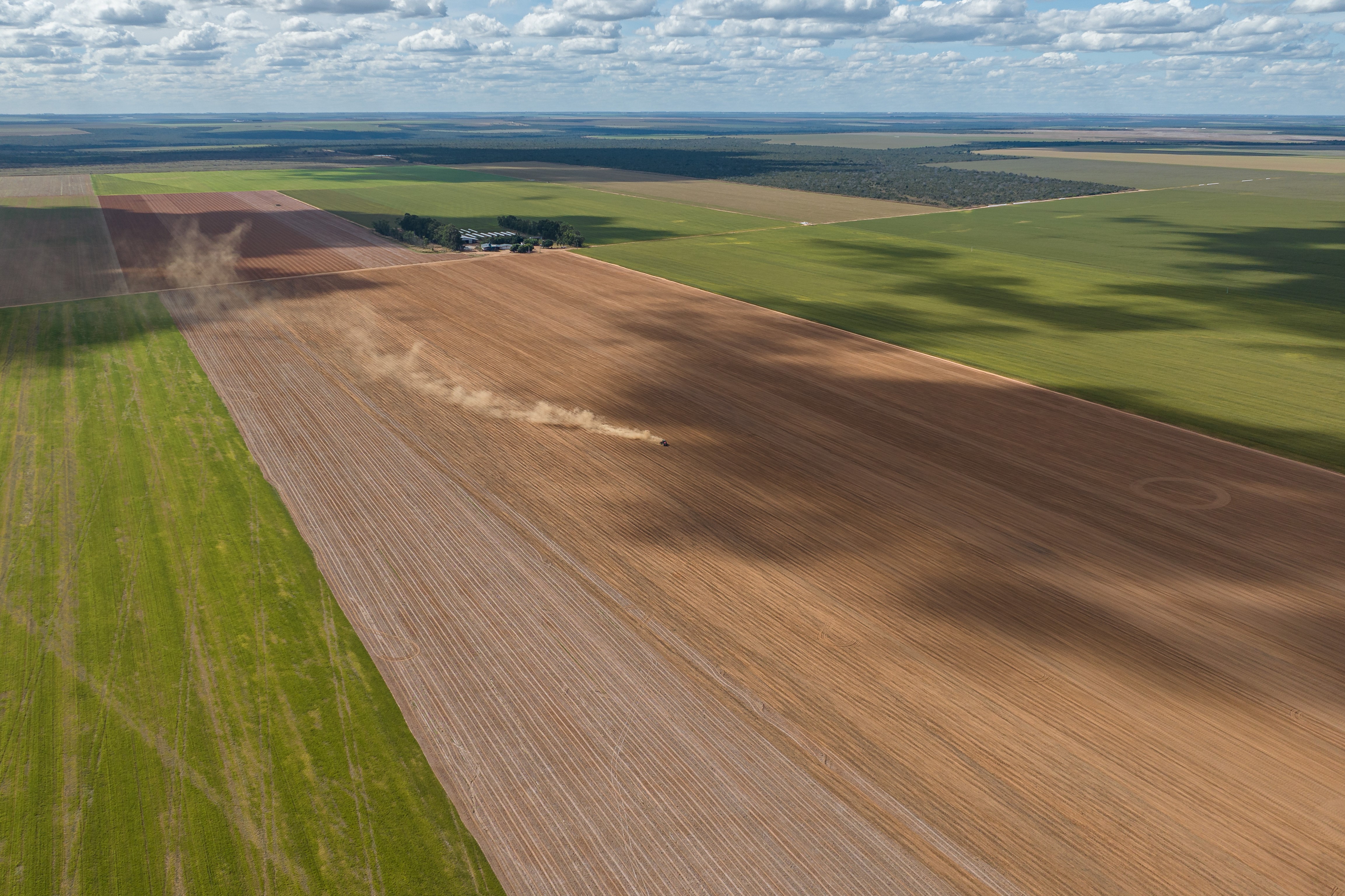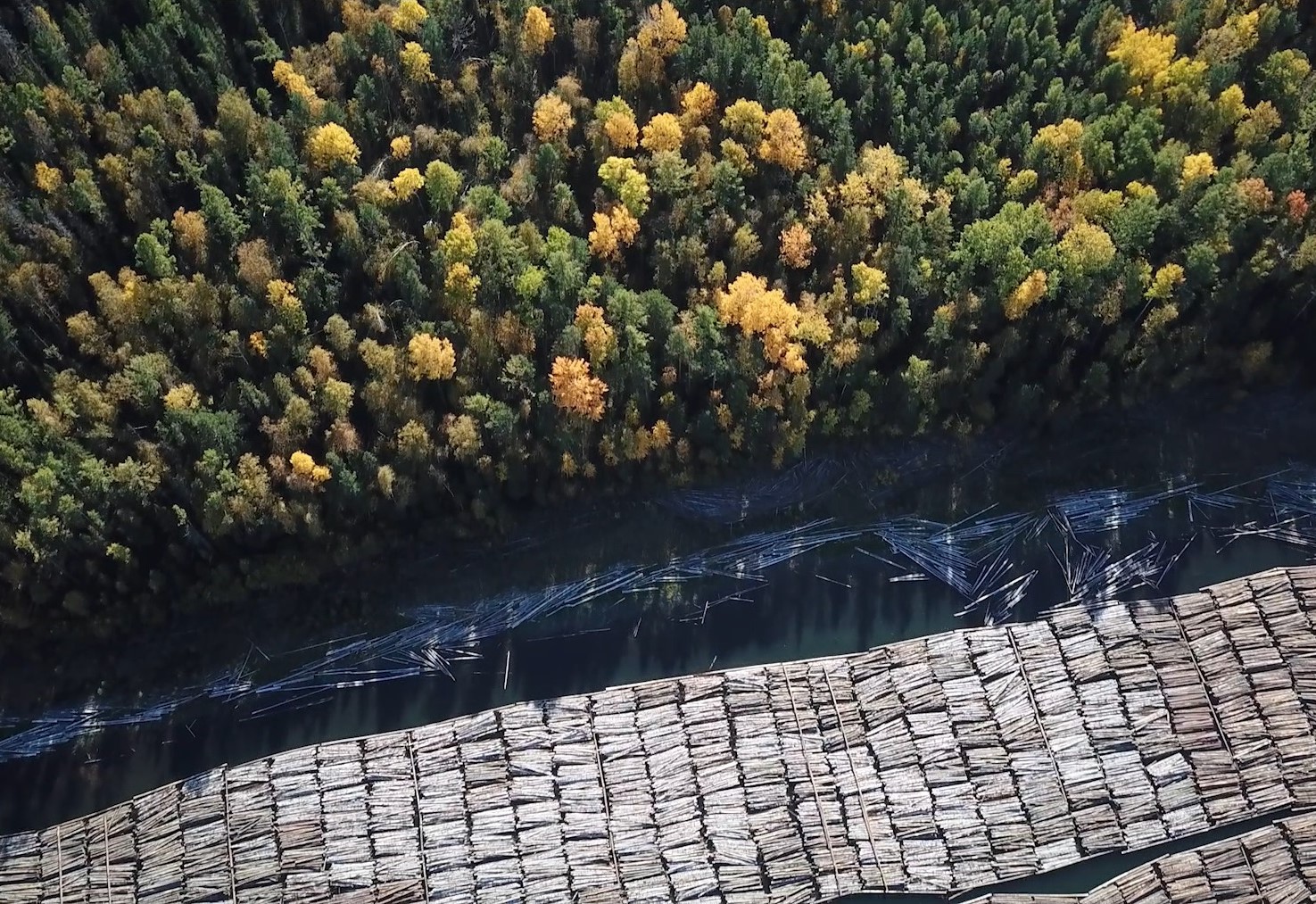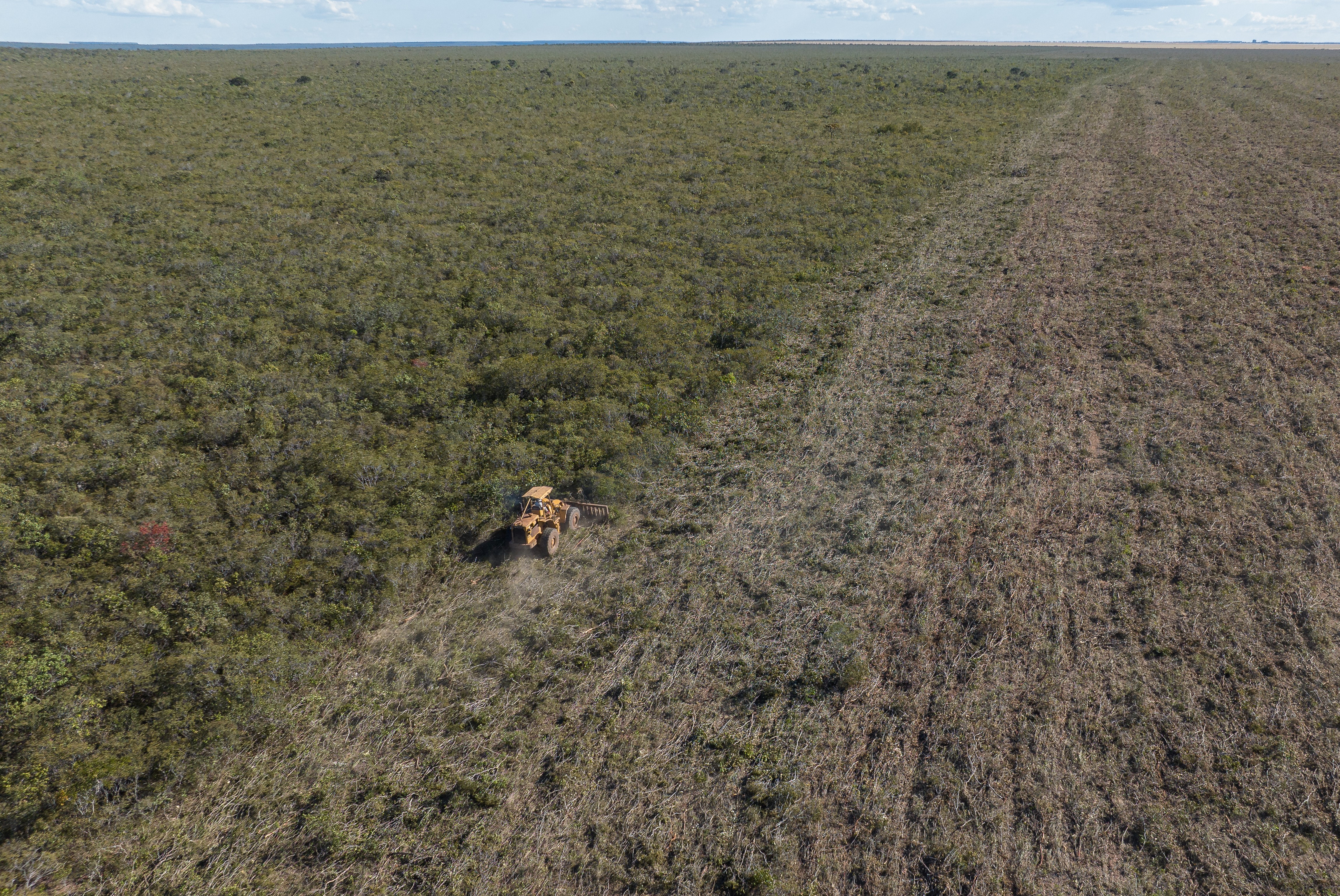On a vast, hot plateau in Paraguay, in the centre of South America, lies a little-known environmental crisis, and a dirty secret that can be traced to the supermarkets of Europe.
The dry tropical forests of the Chaco are being destroyed faster than any other forests on earth. The trees felled as a result of the advance of industrial agriculture into pristine wilderness are being turned into charcoal to feed demand in Europe.
Described by David Attenborough as “one of the last great wilderness areas in the world”,[1] the Chaco is home to a plethora of precious wildlife and one of the world’s last tribes living in voluntary isolation, the Ayoreo.
This is all now threatened by the advance of deforestation. The Paraguayan Chaco is being cleared by large, private companies to produce charcoal and rear cattle for beef, with the majority of production of both destined for export.
The largest exporter of Paraguayan charcoal is a company called Bricapar. Earthsight investigators found a large Bricapar production facility hidden deep in the heart of the Chaco, and witnessed slow-growing, dense hardwood trees being fed into ovens. Satellite images show ten football pitches of forest per day being cleared in the surrounding area.
Bricapar is part-owned by a scandal-ridden government Minister. The company obtains raw materials from an area of land belonging to the state social security fund, but which was allegedly leased to an intermediary company at an eighth of its market value. Signs of the presence of uncontacted Ayoreo have been found just 40 kilometres away.
Earthsight has traced charcoal from Bricapar’s forest destruction in the Paraguayan Chaco to supermarkets in the EU and US, including major chains Lidl, Aldi and Carrefour. Our analysis shows that the EU is the largest export destination for Paraguayan charcoal, and that the equivalent of up to 30 football pitches of Paraguayan Chaco forest are being cleared every day to supply Europe with charcoal.
Bricapar’s EU distributor is peddling false and misleading claims regarding the sustainability of the products flooding European supermarket shelves, masking its role in this environmental crisis.
The Chaco, Charcoal, & Uncontacted Tribes
Located in the heart of South America, Paraguay’s landscape is divided decisively in two. To the east stretches a rain-soaked land once covered in subtropical forest, now submerged beneath a sea of soya plantations. To the west lies the Gran Chaco, a vast plain where tropical dry forests shelter indigenous people living in voluntary isolation. For centuries, its forbidding landscape deterred colonisers and, in recent decades, the agricultural companies that expanded aggressively into the east of Paraguay. The Gran Chaco encompasses parts of Bolivia, Argentina and Brazil as well as Paraguay, composing a vast biome less famous than the iconic rainforests of the Amazon some 1,000 kilometres to the north. It has several endemic species and high levels of biodiversity, including 3,400 plant species, 500 birds, 150 mammals and 220 reptiles and amphibians. Its position at the heart of the continent makes it an important refuge for migrating birds. Jaguars prowl its forests, hunting tapir, peccary, giant armadillo, capybara and giant anteaters.[2]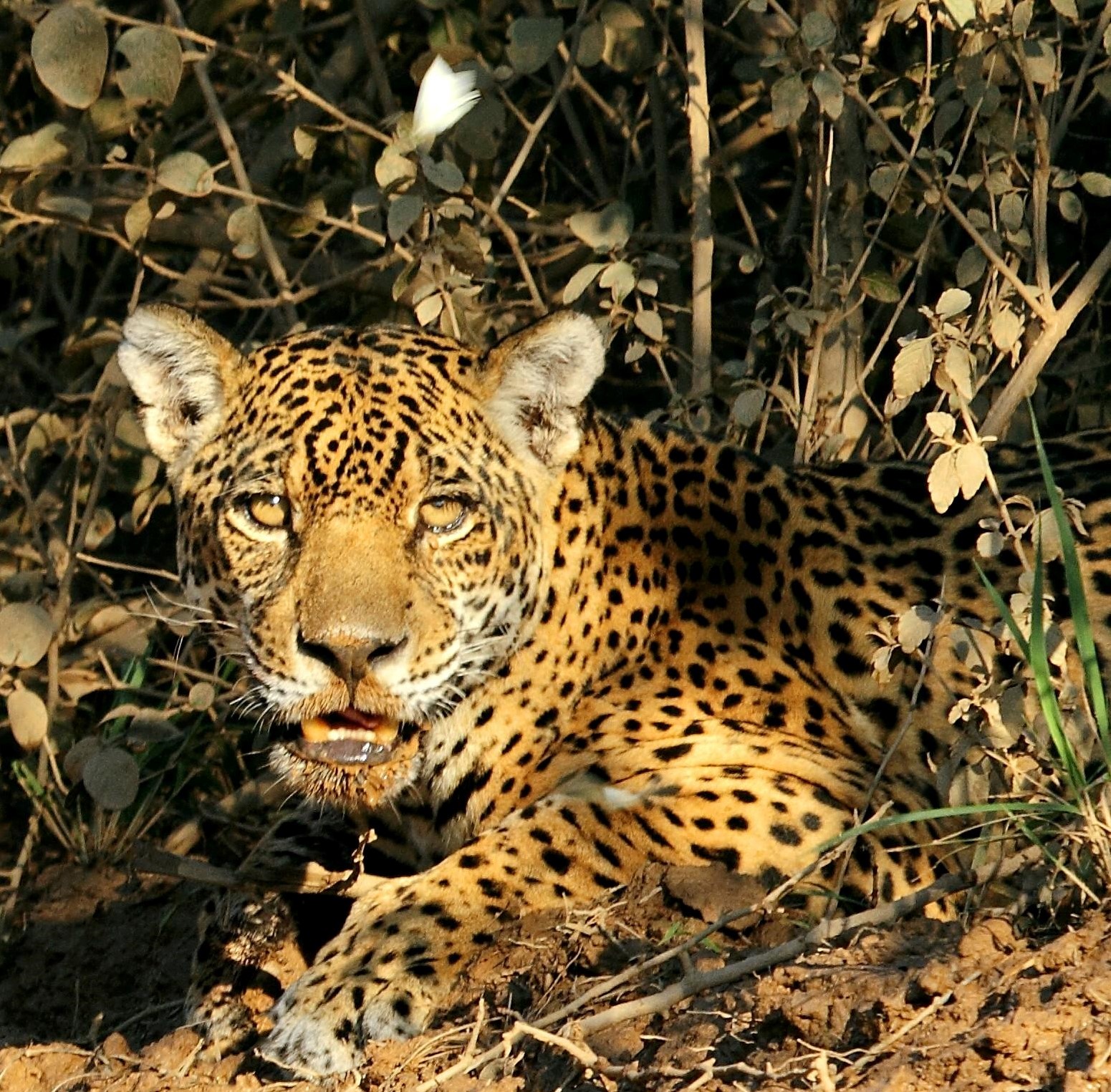
Figure 1: Jaguar photographed in the Gran Chaco forest.
Much of the land in the sparsely-populated Chaco — including nearly all of the Paraguayan Chaco — is the ancestral territory of various indigenous groups. Most notable among them are the Ayoreo, whose territory encompasses more than half of the Paraguayan dry Chaco along with additional areas in neighbouring countries. The Ayoreo are a nomadic people, and a number of them continue to live in voluntary isolation, ranging across remote stretches of the Paraguayan Chaco. They are the only remaining ‘uncontacted’ indigenous group outside the Amazon basin. Since the 19th century, their way of life has been threatened by the advance of missionaries who have forced many into sedentary lives of poverty. Over the past few decades their territory has come increasingly under threat by the seemingly inexorable advance of modern agriculture.[3]
Commodities and Deforestation
In the past two decades Paraguay has experienced a radical
transformation of its landscape and economy. While it has always been heavily
dependent on agriculture, this is increasingly dominated by the large-scale
industrial production of soy and beef for export.[4] With
a population of just six million people, it is now the sixth largest exporter
of soy beans and seventh biggest exporter of beef. Control of these industries
is overwhelmingly concentrated in the hands of private companies and a small,
wealthy elite. Measured by distribution of land, Paraguay is the most unequal
society in South America. According to a 2008 census, just 1.6 percent of the
population controlled 80 percent of all agricultural land. Meanwhile 180,000
families, out of half-a-million families living in rural areas, lived without
access to enough farmland to subsist.[5]
Until the middle of the last decade, the growth of
industrial agriculture came largely in the east, at the expense of the Atlantic
Forest that once stretched from the river Asuncion, through Brazil and to the
Pacific coast.[6] The
almost total destruction of these forests prompted the government to announce a
moratorium on deforestation[7],
which has been for the most part enforced and observed, preserving what
remained of the Atlantic Forest within Paraguay. Enacted in 2004, the “Zero
Deforestation Law” applied only to the east of the country, and perhaps
inevitably sparked a commensurate rush for land in the Chaco.[8]
While conditions in the Chaco are not appropriate for the
cultivation of soy (though sufficiently heat-resistant strains are reportedly
in development), it is suitable for cattle ranching. A lack of new land in the
east led to price rises and in some cases ranchers sold their holdings to soy
companies and bought land at cheaper prices within the Chaco. The rise in
deforestation in the Chaco, according to data on Global Forest Watch[9],
coincides with both the moratorium in the east and a sharp rise in the volume
of Paraguay’s beef exports. As with soy, cattle ranching is overwhelmingly
dominated by large farms controlled by wealthy landowners.
According to data on Global Forest Watch[10],
deforestation in the three departments that comprise the Paraguayan Chaco
tripled between 2006 and 2007, and have remained dramatically high in the years
since. By 2013, due in large part to the situation in western Paraguay, a
pioneering study found that the forests of the Chaco were disappearing at a rate
faster than any other tropical forests in the world.[11]
The analysis, by the University of Maryland, covered the 12
years after 2000, a period in which the dominant story about South America’s
forests was the remarkable success in reducing deforestation in the Brazilian
Amazon. The rampant destruction of the Chaco, which stretched up to the borders
of Brazil’s Amazon states, had gone under the radar. Yet by any measure the
extent of forest loss in this lesser-known corner of South America merited
global attention. Only four countries lost more tropical forest during the 12
years than Paraguay: Brazil, Indonesia, Congo and Malaysia. But these countries
had a lot more left to lose. Of all the countries with significant tracts of
tropical forests, only Malaysia had a higher rate of forest loss than Paraguay.[12]
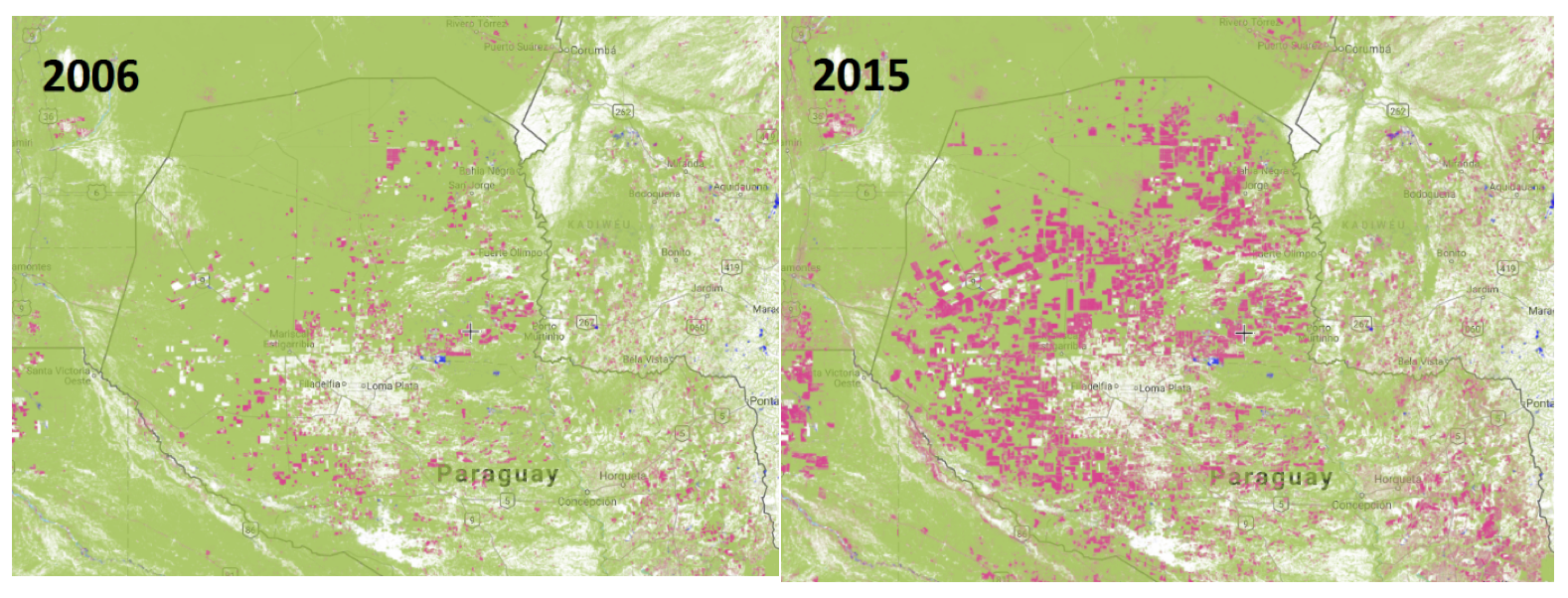
Figure 2: Deforestation in the Paraguayan Chaco, 2006–2015.
The Paraguayan non-profit Guyra monitors deforestation on a
monthly basis, using the same datasets as the University of Maryland study.[13] The
latest available analysis, covering January 2017, suggests that the rate of
deforestation has kept pace since the University of Maryland paper. The
Paraguayan Chaco is on course to lose more than 200,000 hectares of forest this
year: an area the size of Manhattan every fortnight.[14]
While cattle-ranching for beef production is the primary
driver of deforestation in the Chaco, charcoal production also plays an
important role. It provides a further, lucrative, incentive to destroy what
remains of the Chaco and helps cover the up-front costs of clearing forest for
cattle.
The dense, slow-growing hardwood trees of the Chaco provide high-quality charcoal which burns hot and slowly with little smoke. The most sought-after species is Quebracho blanco (Aspidosperma quebracho-blanco), among the largest tree species in the region. The Quebracho tree is important for indigenous groups like the Ayoreo, who collect honey from nests in its branches.[15] The rapid deforestation in the Chaco provides a steady supply of these species, and has enabled Paraguay to become one of the world’s top five charcoal exporters.[16]
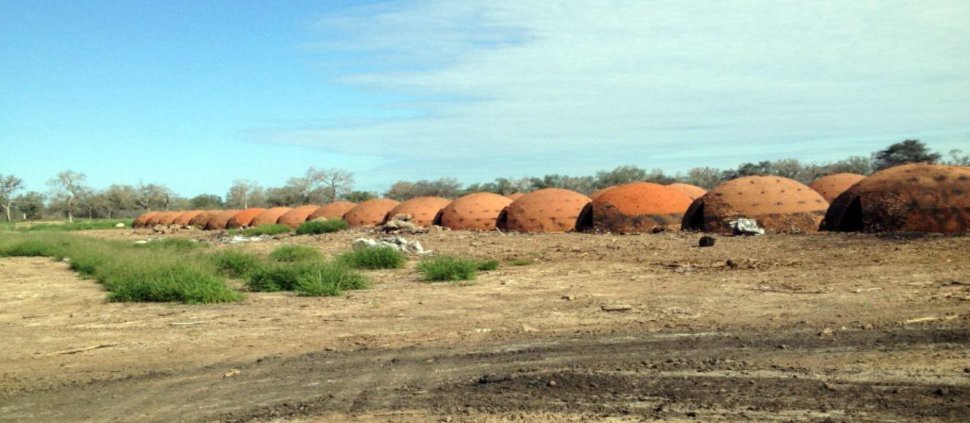
Charcoal production facility in the Paraguayan Chaco.
The Impact on the environment and indigenous people
The model of production of beef and charcoal is having a devastating impact on the biodiversity of the Chaco. While some patches of forest are being retained, the fragmentation of forests makes it harder for large animals such as puma and jaguar to move around: their territory shrinks, threatening them with starvation. Forest clearances by waterways make it more difficult for smaller animals to establish themselves near water reserves. Some species endemic to the Chaco, such as the Chacoan peccary (Catagonus wagneri), face extinction as a result of the destruction of their habitat.[17]The Chaco is highly susceptible to soil erosion and desertification, a condition exacerbated by deforestation.[18] It experiences some of the highest temperatures on the South American continent.[19] Clearances expose land to the sun, increasing evaporation rates. Climate change is likely to elevate temperatures further, as well as diminishing rainfall, extending desertification further. These conditions combined with the establishment of farms and factories, place pressure on limited water reserves.
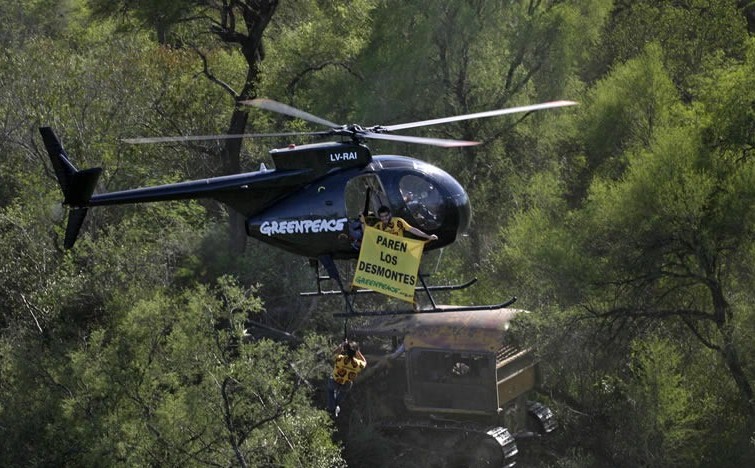
Greenpeace protesting clearance of Chaco forests in Argentina.
In addition to having a devastating effect on wildlife, the
clearance of the Paraguayan Chaco is also impacting indigenous people,
including the ‘uncontacted’ Ayoreo tribe, whose historic range encompasses half
of the Paraguayan dry chaco.[20]
As the area of available land outside ranches diminishes, the ability of the Ayoreo to remain in voluntary isolation, a right protected under international law, is reduced. The UN Special Rapporteur on the rights of indigenous peoples has raised the urgency of this issue with the Paraguayan government repeatedly. Most recently, in August 2015, it warned of “serious threats posed to groups in isolation by the relentless spread of deforestation”.[21] In February 2016 the Inter-American Commission of Human Rights passed a resolution urging the Paraguayan government to take precautionary measures to protect Ayoreo communities in voluntary isolation, and avoid deforestation in their customary lands. A summary of the resolution stated that the communities were “in a serious and urgent situation given that their rights to life and personal integrity are allegedly threatened and at risk”.[22]
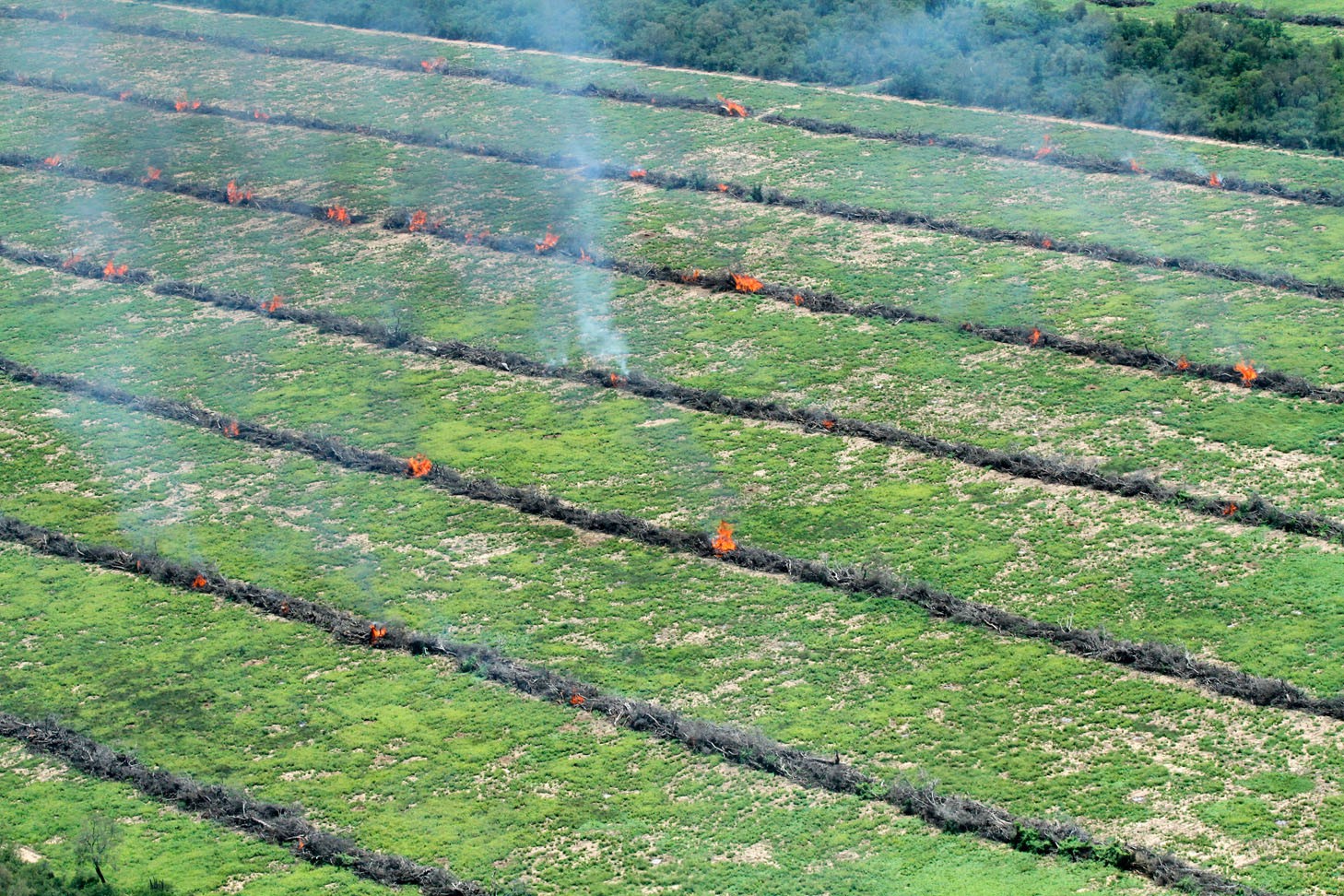
Chaco forest converted into cattle pasture near Mariscal Estigarribia in the Paraguayan Chaco.
Indigenous groups are not afforded the right to withhold consent to intensive agriculture projects in their customary lands as international legal norms require. Though the Paraguayan constitution recognises the rights of indigenous peoples, the Special Rapporteur noted in 2015 that that intent “has not been translated into the legislative, administrative or other measures needed to ensure the enjoyment by indigenous peoples of their human rights, in particular their fundamental right to self-determination and their rights over their lands, territories and natural resources”.[23]
The Paraguayan justice system has demonstrated itself to be incapable of enforcing the few legal measures that have been taken to protect indigenous peoples, repeatedly issuing licenses in areas hotly contested by indigenous people of the Chaco.[24] In response, indigenous peoples and their representative institutions have sought recourse in international fora. In a 2015 case, the Inter-American Court of Human Rights found that the Paraguayan Environment Ministry had violated Paraguayan law by issuing environmental permits for ranching, forestry and oil exploration in territories claimed by indigenous peoples.[25]
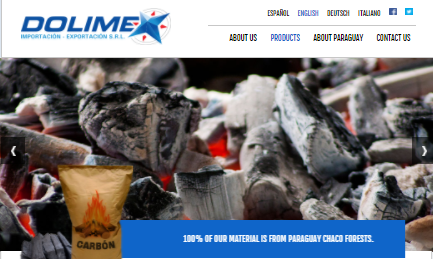
Webpage of Paraguayan charcoal exporter Dolimex, advertising that the products come from Chaco forests.
From the Chaco to the Checkouts
The EU is by far the largest destination for Paraguayan charcoal exports, with the US also a significant importer. The importance of the EU as a market for Paraguayan charcoal has been growing rapidly. Ten years ago, 20 percent of exports were destined for the EU.[26] In the first three months of 2017, it was more than 70 percent.[27] Germany and the UK are the largest buyers of Paraguayan charcoal. During early 2017, some 22,000 bags of Paraguayan charcoal were entering Germany every day, and 5,000 were arriving in the UK.[28] Paraguay is the largest source of charcoal imports to Germany, and one of the top three for the UK.[29] Earthsight estimates that as many as 30-football pitches of Paraguayan Chaco forest are being cleared every day to supply Europe with charcoal.[30] Most charcoal being sold in supermarkets in Europe and the US, or used in restaurant and hotel chains, is supplied by EU and US distributors. These companies order charcoal from overseas, where it is packaged by the supplier in the distributors’ own branding, or that of their customers. While the products on the supermarket shelves rarely identify the true origin, many of these distributors openly advertise that their products are made from Quebracho sourced from Paraguay. The Paraguayan companies that supply them also advertise this fact. They also commonly provide information on their websites about their overseas buyers. For example, Dolimex, one of the top four Paraguayan exporters in 2016, boasts on its homepage that “100% of our raw material comes from the forests of the Paraguayan Chaco, where there are [sic] an abundance of high density species such as the quebracho blanco.”[31] Dolimex’s website includes pictures of bags of charcoal destined for two major UK importers/distributors, Big K and Fuel Express,[32] whose charcoal is distributed through thousands of independent shops and through petrol station chains across the UK. When asked to respond by Earthsight, Big K confirmed that it sources charcoal from Dolimex and that the raw materials come from clearance of land for cattle farming, but stated that it is their understanding that this is “bush land”.[33] They later also referred to it as “farmland”.[34] They declined an opportunity to deny their supplier’s claims that the land concerned is within the Chaco or that the raw materials are quebracho blanco trees. Fuel Express did not respond to Earthsight’s requests for comment.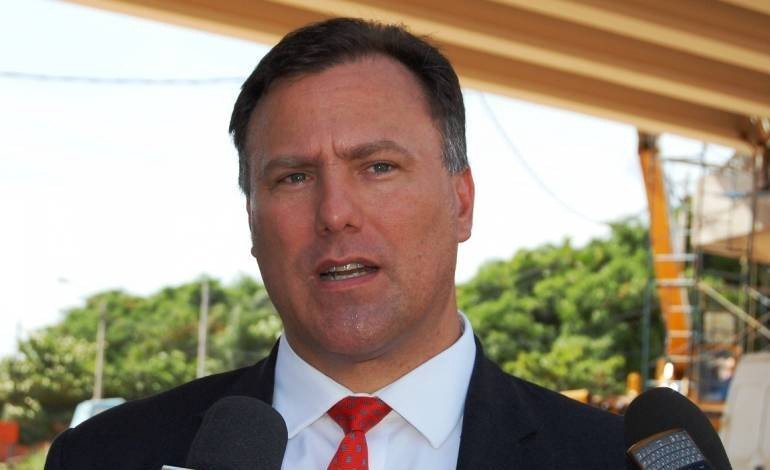
Ramón Jiménez Gaona, Paraguayan Minister of Public Works and major shareholder of leading Paraguayan charcoal exporter, speaking to the press about sustainable development in March 2017.
In the US, the evocatively named charcoal distributor
Jealous Devil specifically markets its charcoal as being made from Quebracho
blanco from Paraguay. It claims the wood is “sustainably harvested”, though
also acknowledged that it is from “timber from developing farms”, which almost
certainly means clearing forests in the Chaco for cattle.[35] The
charcoal is sold direct to consumers through Amazon and Ebay.
While a number of Paraguayan companies are selling charcoal to the EU and US made from the destruction of Chaco forests, Earthsight has focused its investigation on the largest, a company called Bricapar. We located and visited the company’s charcoal facility in the Chaco, analysed the deforestation which has been feeding it, explored the company’s ownership and traced its products into some of the world’s largest supermarket chains.
The Minister
Earthsight’s investigations have uncovered that a major shareholder of Paraguay’s leading charcoal exporter is also one of Paraguay’s most powerful ministers, Ramón Jiménez Gaona. From a base in the west of the Chaco, far from public scrutiny, Gaona’s company is earning millions of dollars in revenues by processing trees cut to make way for cattle.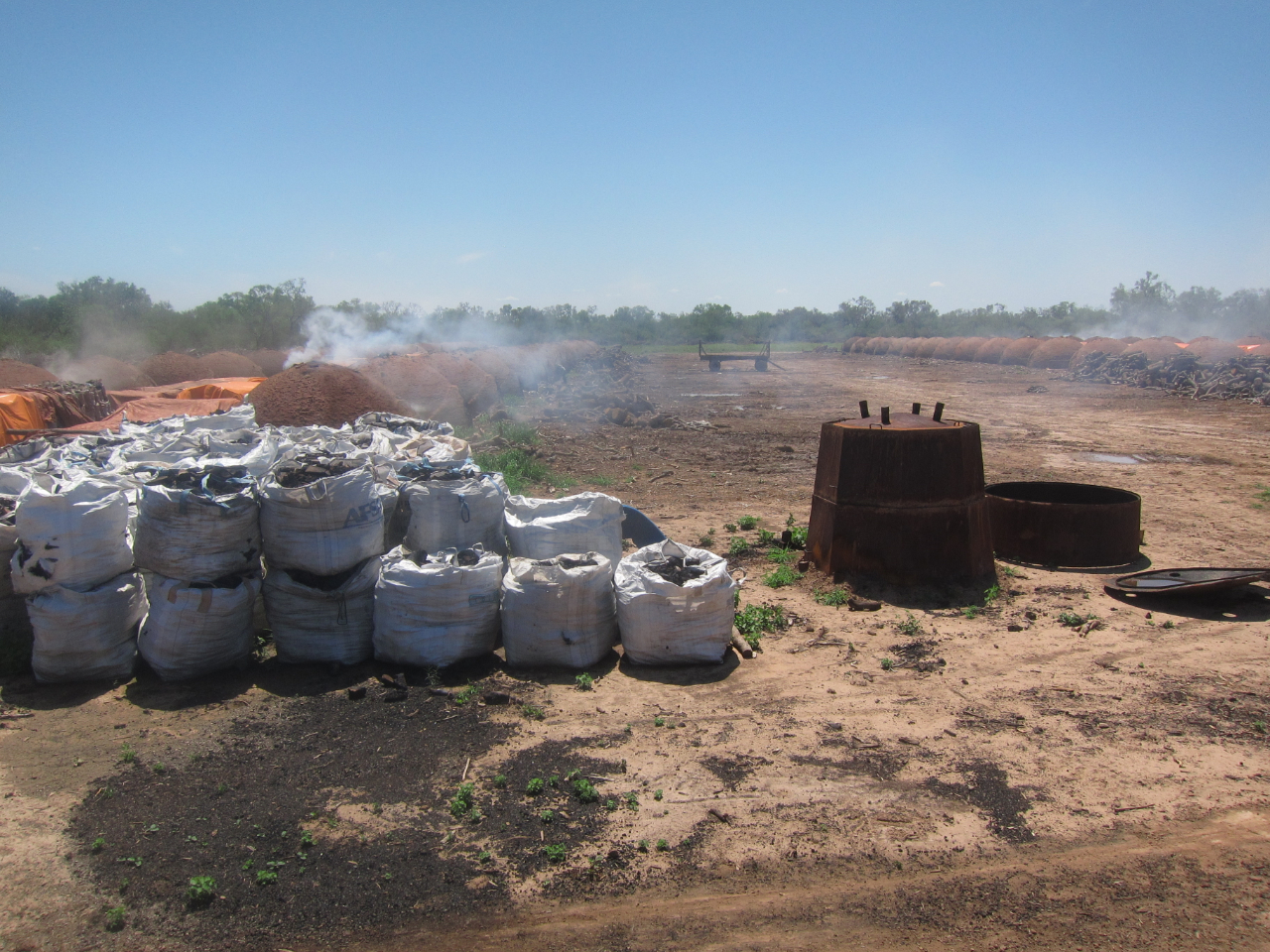
Bricapar charcoal facility at Teniente Ochoa.
Paraguayan politics is dominated by the long shadow of the Colorado Party. This was the party of the dictator General Alfredo Stroessner, whose murderous regime held onto the country for 35 years. Although it is now ostensibly a democracy underpinned by the 1992 constitution that bookended Stroessner’s regime, his party remain in power today. Since the 1940s the only break in its power was the administration of a left-leaning coalition led by former Bishop Fernando Lugo, who took the presidency in 2008.
It seemed a watershed moment for Paraguayan democracy: the first non-Colorado government in 61 years. But in 2012, following a massacre at a land occupation that left four police and 13 peasant farmers dead[36], Lugo was impeached by Congress. Neighbouring countries condemned the process as a constitutional coup, suspending Paraguay from the trade bloc Mercosur.[37] Ten months later, in April 2013, the Colorado Party was back in power under the leadership of President Horacio Cartes, following an election marred by allegations of corruption and vote-buying.[38]“Use and abuse Paraguay. The land is yours, the country is yours.”As his Minister of Public Works, Cartes appointed Gaona, a heavy-set former discus thrower who represented Paraguay at the 1996 Olympic Games. The position is one of the most influential in government, with Gaona one of 12 members of Cartes’ cabinet. Gaona is implicated in a series of scandals relating to the tendering of a US$23 million construction contract with a Spanish company, which have culminated in the Paraguayan Public Prosecutor opening a criminal investigation against him for “breach of trust and criminal association”.[39] Gaona’s troubles began when a report compiled by the Spanish police implicated him in an “international corruption” scheme ran by the notorious businessman Jordi Pujol.[40] In Paraguay, the allegation referred to the contract-tendering process for the construction of a huge viaduct and overpass in 2014. The contract was awarded to the Spanish firm Isolux, described in the police report as “the paradigm of this operation, in terms of its special financial and operative capacity to arrogate the ability to bid for these projects”.[41] The situation worsened for Gaona after the viaduct in question was flooded in the first week of June 2017. At this point, the designer of the project, engineer Hermann Pankow, lodged a complaint against Gaona and five members of the evaluation committee that had awarded to the contract to Isolux. Pankow alleged that, after the original contract had been signed, they had modified the original plans, lowering the overall costs of the project for Isolux.[42] Gaona has “denied categorically” that he received any kind of payment in return for awarding the contract for the viaduct, threatening to sue Paraguayan newspaper ABC Color for implying that he had.[43] In the year before he was appointed to the cabinet, Gaona’s charcoal firm was already the country’s largest exporter, responsible for a quarter of all exports.[44] Since then its fortunes have rapidly improved. By the first quarter of 2017, it was responsible for almost half of all exports.[45] Its sales of this charcoal in early 2017 were bringing in around US$1 million per month in revenue.[46]
President Horacio Cartes to Brazilian ranchers, 2014
The land: Teniente Ochoa
Bricapar has four charcoal production facilities in Paraguay. One of its production sites is in the department of Boqueron, in an area of land known as Teniente Ochoa, more than 500 kilometres from the capital of Asuncion and deep in the Chaco.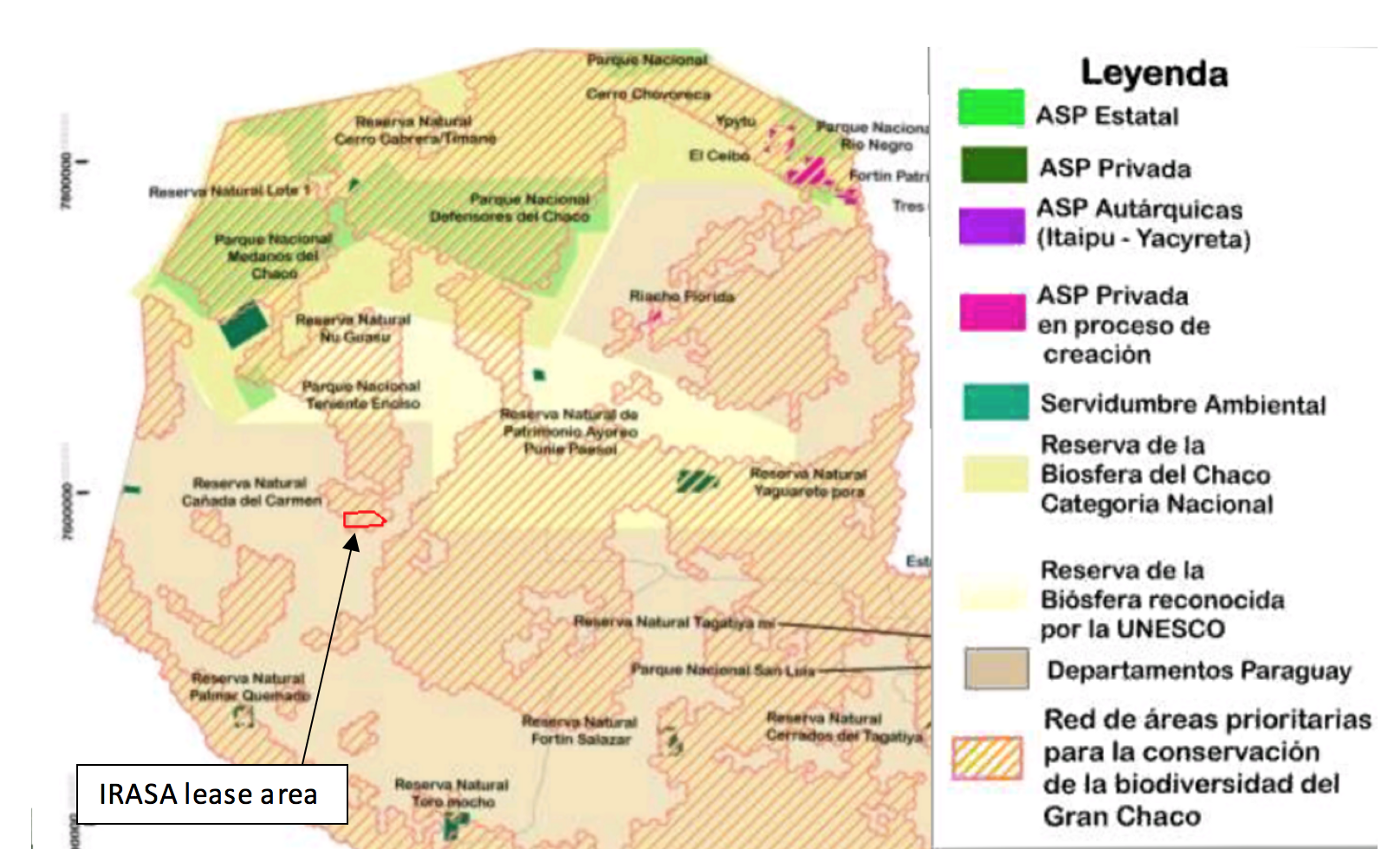
Map of priority areas for conservation in Western Paraguay from 2010, showing IRASA lease.
The ownership of all land in the Paraguayan Chaco has been
mired in controversy since the fall of Stroessner’s regime. During his
dictatorship, almost eight million hectares had been parcelled up and
irregularly awarded to friends of the regime, principally family members and
political and military allies of the dictator — many of them members of the
Colorado Party. The Lugo government sought to unpick the legal tangle created
by this hand-out, in order to reallocate land equitably. But those efforts have
stalled and landholdings within the Chaco have been sold on to third parties,
principally cattle ranchers.
The land occupied by Bricapar’s Teniente Ochoa facility, and
which provides a large proportion of the raw material for its exports to Europe
and the US, is however owned by the Paraguayan Social Security Institute, or
IPS. The IPS is a state entity in charge of social security in Paraguay.
Employers and workers pay into it each month to be covered in the case of
illness, maternity, disability, work accidents, retirement, and unemployment.
Though it is on one of the few patches of the Chaco which was not part of the
irregular land allocations to occur during the Stroessner era, this IPS land
has proved controversial in other ways.
The IPS owns a total of 200,000 hectares in Teniente Ochoa,
which it rents out to various agricultural companies.[47] One
of them is IRASA, which has a 20-year lease on three lots totalling 18,000
hectares.[48] IRASA
was first granted authorisation to begin clearing forest on the site in 2009,
in a permit issued by the Paraguayan Forestry Institute and seen by Earthsight.[49] Bricapar
signed a contract with IRASA to cut trees and produce charcoal on this land in
2012.[50]
The IRASA land in which Bricapar is operating lies within an area of the Chaco that was classified as ‘Intact Forest Landscape’ (IFL) until recently. These are large, undisturbed areas of forest around the world that are considered critical for harbouring biodiversity, regulating hydrological regimes and stabilizing terrestrial carbon storage.[51] The entire area of the IRASA lease at Teniente Ochoa, in which Bricapar is clearing forest, lies within an area of the Chaco previously identified as a priority area for conservation of rare, endangered and endemic species[52] (see map).
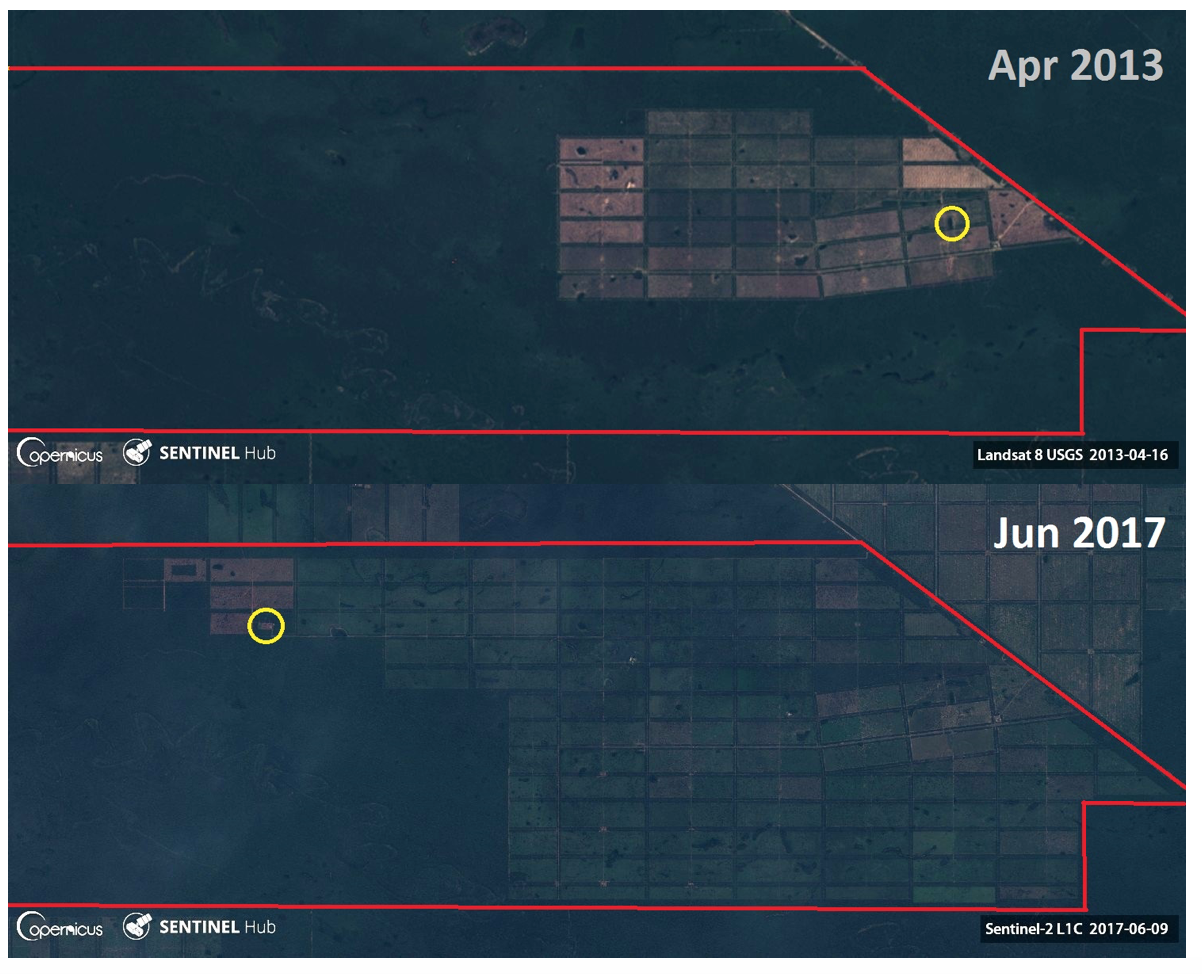
Deforestation within IRASA lease (red) at Teniente Ochoa and position (yellow) of previous and current Bricapar charcoal facilities.
Deforestation feeding Bricapar
The first clearances within the IRASA license area began in 2010, soon after the lease was first issued. However, it was only after 2012 — the year that Bricapar first signed a deal with IRASA regarding charcoal production — that deforestation really took off. In 2013, satellite images show more forest was cleared than in the two previous years combined.[53] In 2014, local journalists visited the large charcoal facility at the site, which had 120 kilns and a production capacity of 1260 tonnes per month.[54] To keep pace with the deforestation, which was working gradually west from the highway, in the middle of 2015 charcoal production was shifted to a new site. Analysis of satellite imagery shows that Bricapar’s current facility was built at some point in late 2015. Soon after, deforestation within the IRASA land accelerated to new heights, with a record 1800 hectares converted in just the first nine months of 2016. This is an average of ten football pitches of clearance every working day. Additional large new areas of clearance also took place in a ranch to the north of the IRASA lease, and a road was built directly connecting this new conversion to the Bricapar facility (see Figure 12).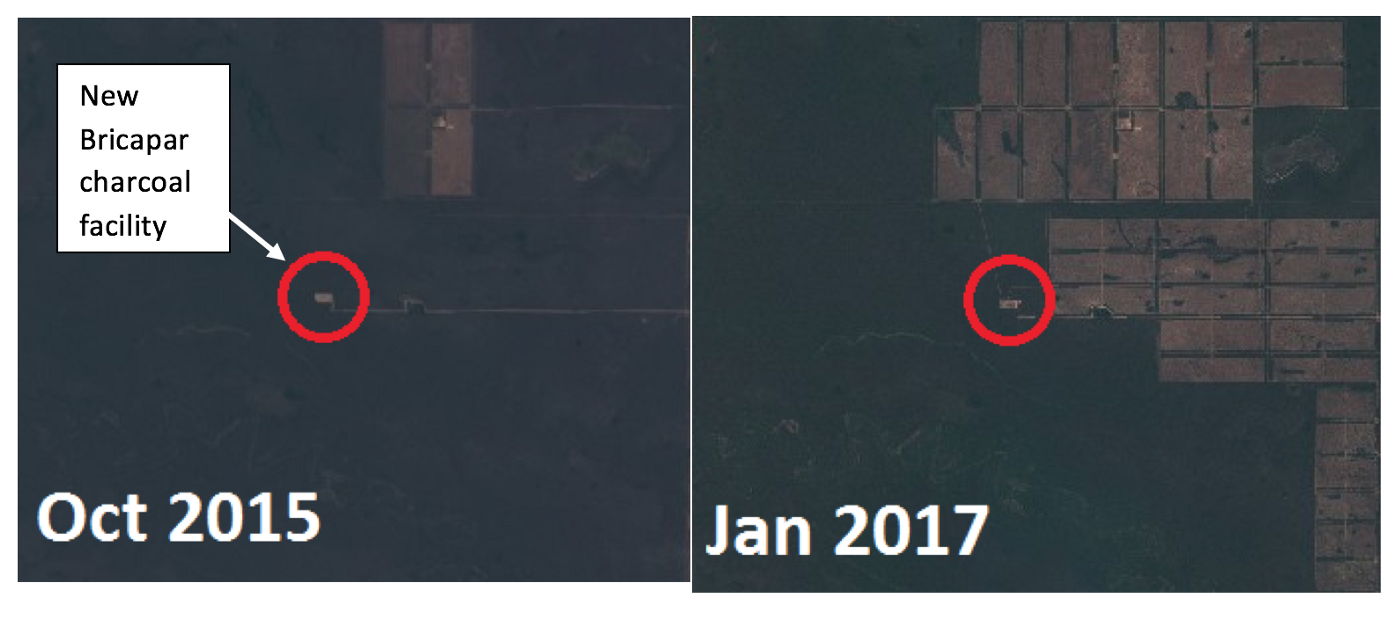
Recent deforestation around the current Bricapar charcoal facility at Teniente Ochoa, Oct 2015 — Jan 2017.
The permit allowing for conversion of natural vegetation to
cattle pasture at the IRASA lease at Teniente Ochoa follows standard Paraguayan
regulations, which require the conservation of 25 percent of the total land
area, along with buffer strips of forest around each block of land clearance,
plus the protection of forest close to water sources. From an analysis of
satellite images, it appears that these controls have been complied with inside
the IRASA land where Bricapar is operating. In addition, in its response to
Earthsight, Bricapar claimed that 30 percent of the standing trees within each
conversion ‘plot’ were also being retained. Bricapar also noted that an
Environmental Impact Assessment was carried out for the lease area.
However, satellite images and Earthsight’s own field visit clearly show that within the areas of the IRASA lease where Bricapar is sourcing its charcoal (separate to the 25 percent forest reserve), while some individual trees are retained, the majority of the land is being entirely cleared of natural vegetation to make way for cattle pasture (see Figure 11), activities which constitute ‘deforestation’[55] and cannot reasonably be described as ‘sustainable’.
He explained that there were plans to expand the facility, increasing its capacity to consume the surrounding forests. Around 40 people work at the site, engaged in the hard labour of cutting and hauling trees, and packing the brick ovens ready for each ‘burn’. No protective equipment was seen, and workers complained of persistent coughs.
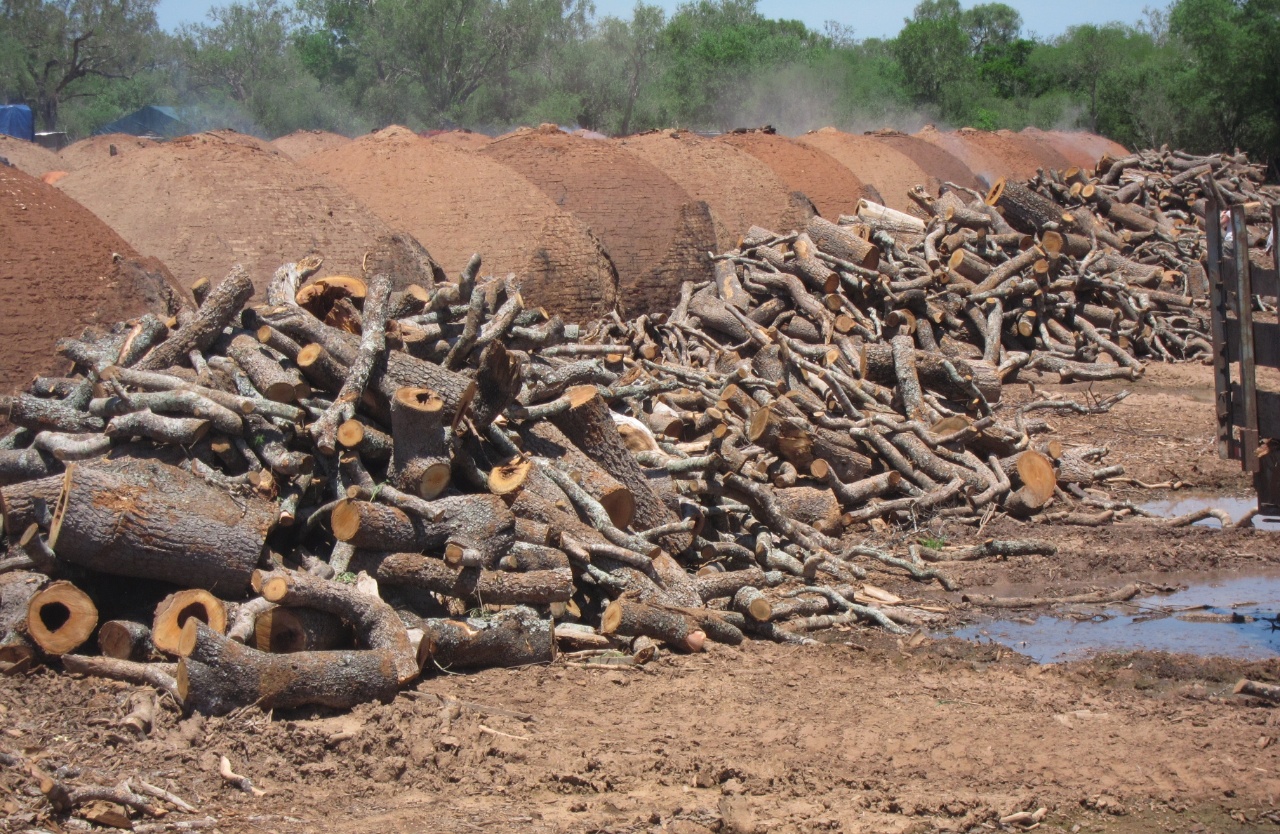
Some of Bricapar’s charcoal ovens at Teniente Ochoa.
Controversial cutting
Earthsight’s research has raised further questions regarding the propriety of Bricapar’s access to the forests from which it is producing charcoal, and the role of its major shareholder as a government minister.In 2014, an investigation by the national newspaper ABC
Color discovered that the IPS was renting out this land for what it described
as “giveaway prices”: an average of less than 15 pence (19 cents) per hectare
per month. [59] This
is one-eighth of the price-per-hectare that experts told the paper would be
expected in the area, described by the paper as a privileged location with high
productivity and good access to cities and markets. IPS denied the allegations,
claiming that the leases were issued by public tender at market values. One of
the key case studies highlighted by the paper in its series of articles on the
IPS land was that involving IRASA, which now sub-leases the land to Bricapar. IRASA’s
owner has denied wrongdoing.[60]
Earthsight presented this information to Bricapar prior to
publication. In response to this the company wrote, via a law firm, that it
“does not know the fixed price” between IRASA and IPS.
The potential for conflicts of interests stemming from the
role of Bricapar’s major shareholder as Minister for Public Works is
demonstrated by at least one project. As part of his ministerial portfolio,
Gaona is in charge of Paraguay’s state infrastructure projects. One such
project, tendered in February 2015, involved the reconstruction of a stretch of
the Transchaco Highway. The road connects Teniente Ochoa, the site of
Bricapar’s production facility, to Asuncion. In all the project covered 173km
of road, at a cost of US$54 million. The section Gaona prioritised was 58km
running past the IRASA land at Teniente Ochoa where Bricapar’s products are
being produced to the nearest major settlement to the south.[61]
When asked about this by Earthsight, Bricapar stated that
since it relates to government activities, we should address our questions to
the authorities. Bricapar also claimed that since Gaona stepped down from the
board of Bricapar when he became a Minister in 2013, there can be no potential
conflict of interest.[62] However,
records show that the Minister has retained his 25 percent shareholding in the
company, which remains under the majority control of his family, including his
brother Manuel, who took over as Chairman.[63]
While the leased area is outside territory commonly regarded
as the ancestral lands of the Ayoreo, it remains possible that Bricapar’s
activities may be impacting on the ‘uncontacted’ tribe. No one knows for
certain precisely where these people are. Communication between the Ayoreo in
voluntary isolation and those in a state of “initial contact” indicates that
the former take great effort to avoid any contact with outsiders. They are also
known to range across very large areas.
Signs of the presence of isolated Ayoreo (such as temporary
dwellings and trees felled with stone axes) have been found during the early
2000s across most of the Ayoreo’s historic territory, which encompasses almost
95,000 square kilometres. The IRASA land lies just two kilometres from the
approximately mapped boundaries of the Ayoreo’s historic lands, and there are
relatively recent finds suggesting their presence as little as 45 kilometres
away.[64]
In its response to Earthsight’s allegation that Bricapar’s
charcoal was being sourced from land close to the traditional nomadic
territories of the Ayoreo, the company stated that “the Ayoreo people are not
within the defined area as direct or indirect influence area of the project”.
The company also stated that the raw material does not come from protected
areas, national parks or reserves for indigenous communities, and that its
facility is 81 kilometres from the southern limit of the nearest protected
area.[65] Earthsight
wrote to the company to clarify that the ‘traditional nomadic territories’ of
the Ayoreo it was referring to are those in the map below (Figure 14), which
differ from the indigenous reserves identified to-date by the Paraguayan
government.
Bricapar declined to provide further comment on the substantive issues and instead argued that Earthsight has “demonstrate[d] that your manifest interest is to damage the credibility of Bricapar”.

Map of Ayoreo territory overlaid with boundaries of IRASA lease area (red) within which Bricapar’s facility is sited, and the approximate boundary of broader area owned by IPS (yellow).
While Bricapar is certainly sourcing wood from within the IRASA lease, satellite pictures suggest it may also have been sourcing from neighbouring farms within the broader IPS land. Around the time that clearance within the IRASA land came to an abrupt halt in September 2016, a road was constructed directly linking the Bricapar charcoal facility with areas of recent conversion in a separate ranch to the north. Between October 2016 and March 2017, there was no fresh conversion in IRASA or its northerly neighbour, and it is therefore unclear where Bricapar’s raw materials were coming from. Though we have no evidence it was supplying Bricapar, the nearest deforestation during that time was a huge new area on the other side of the Trans-Chaco highway, within historic Ayoreo land. This is one of the largest tracts of recent deforestation anywhere in Paraguay.
The middleman and the markets
From the Teniente Ochoa facility, Bricapar’s charcoal is transferred by truck to a factory near the capital of Asuncion. The factory turns some of the raw material into charcoal briquettes, and packs them and the raw ‘lumpwood’ charcoal into customer-branded packaging ready for export. Compared with its competitors, Bricapar’s sales are particularly geared towards Europe. During the first four months of 2017, 85 percent of its exports were destined for the EU, while a further five percent were shipped to the USA. More than 40 percent of all EU imports from Paraguay during early 2017 came from Bricapar, double the share of its nearest competitor.[66] Bricapar was also the largest supplier of Paraguayan charcoal to both the UK and Germany.[67] The marketing of Bricapar’s charcoal in Europe is handled by a company called Ibecosol. Ibecosol is more than just Bricapar’s distribution arm in the EU. It began sourcing from Bricapar in 1997 and the two firms grew increasingly close, until they were integrated via an exchange of shareholdings.[69] Ibecosol now holds a 26 percent stake in the Paraguayan firm.[70]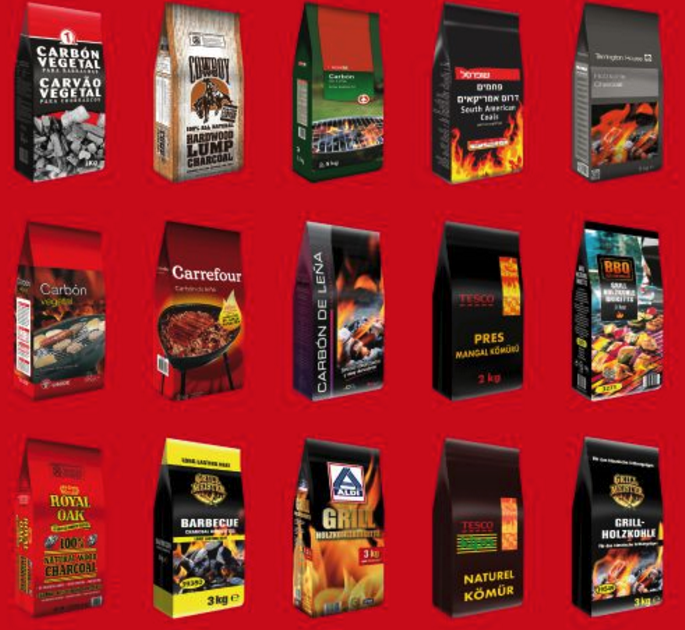
Bags of US and EU customer charcoal shown on Bricapar’s website.
In a 2013 interview, Ibecosol’s chief executive Guillermo
Vega de Seoane said that the two firms had become practically the same company.
“They make, we sell,” he said.[71]
An Earthsight investigator posing as a trade magazine
journalist met with Vega de Seoane in early 2017 at his office in Madrid. He
confirmed that the company’s Paraguayan charcoal is produced by Bricapar at the
Teniente Ochoa facility (along with three other facilities elsewhere in the
country), and boasted of how this charcoal is being sold by some of Europe’s
leading supermarket chains, including branches of Lidl and Aldi in both Spain
and Germany, and branches of Carrefour and Repsol in Spain. Seoane claimed that
his company supplies more than half of the charcoal being sold in Spanish
shops.[72]
He also claimed that further shipments are being sent to a
company supplying the restaurant and hotel sector in the UK, and to unnamed
buyers in Denmark. Trade records obtained by Earthsight also show large volumes
being exported by Bricapar to Poland, and smaller quantities to the
Netherlands, Greece and Italy.[73] Shipments
to these countries and the UK travel direct, while Ibecosol charcoal sold in
Germany and Denmark first passes through Spain. According to Seoane, the sales
in Germany occur via a middleman called Boomex.[74] Ibecosol
also sells its own-brand charcoal direct to consumers across Europe via Amazon.[75]
Earthsight has been able to independently verify some of these claims, with bags of Ibecosol-supplied charcoal found in branches of Lidl and Carrefour in Spain (see Figures 16 and 17).

Ibecosol charcoal briquettes on sale in Carrefour, Spain, 2017 (L) and Figure 17: Paraguayan charcoal supplied by Ibecosol on sale at Lidl, Spain, 2017 (R).
Trade records obtained by Earthsight show that Bricapar shipped more than 2,000 tonnes of charcoal to the USA in 2016.[76] Around two-thirds of this was purchased by US company Duraflame, which is by far the largest US importer of charcoal from Paraguay.[77] Shipment records confirm that this is being supplied under the company’s Charcoal Cowboy brand.[78] Duraflame sourced more than 250,000 bags of this charcoal from Bricapar during 2016.[79]
Charcoal Cowboy is sold through numerous outlets across the USA, including branches of K-Mart nationwide and some branches of Walmart. However, the products sold in these two supermarkets are labelled as made in Mexico. Earthsight contacted Duraflame in advance of publication. The company’s Vice President Chris Caron confirmed that the company sourced from Bricapar, but that it represented a minority of the company’s charcoal supply. He stated that the Paraguayan products were not being sold at K-Mart and Walmart but are being sold in stores and supermarkets in the North-East of the United States. He declined to name any particular outlets. Mr Caron stressed that his company had sought copies of official permits from Bricapar to confirm the legality of its supplies, but was unaware that the charcoal was being made from clearance of natural forest.[80]
Bricapar’s sales in the Americas are not handled by Ibecosol, but in his interview with Earthsight investigators Seaone nevertheless was able to provide some additional insights. He claimed that Bricapar has recently finalised a deal to directly supply Walmart’s stores in Mexico, Dominican Republic and Costa Rica. Earthsight were unable to independently verify this claim.
Earthsight wrote to all the supermarkets which our evidence indicated were selling Bricapar charcoal from deforestation in the Chaco to provide them the opportunity to comment on our findings. Lidl Spain said that it demands “strict sustainability standards in all areas of our business activity” and that it was “certain that our supplier Ibecosol obtains all the necessary accreditations to certify sustainable practices”. It made these claims on the basis of Ibecosol’s PEFC certification.[81] Lidl in Germany failed to respond to repeated requests for comment. Aldi Sud in Germany wrote that Ibecosol“claims to abide [by] its commitments to ensure ecological and social sustainability”, on the basis of its PEFC certification and BFCI accreditation. It added: “Furthermore, the wood is not obtained from tropical forests and the clearance is done only partially.” The company referenced Paraguayan regulations that require 25 percent of all farms to be retained as forest cover, plus buffer strips of forest to be retained around each cleared block.[82] Aldi Nord in Germany confirmed that it had sourced Paraguayan charcoal from Boomex which had originated from Bricapar but stated that its last purchase was in early 2016, and that it would not be purchasing from the company in 2017. It stated that Boomex had obtained official government permits from Bricapar confirming the legality of the production.[83] Carrefour said that it had launched an investigation, and temporarily suspended further purchases of one of Ibecosol’s product lines. It stated that its initial results contradicted the information provided by Earthsight, but did not provide details.[84]Table: Bricapar charcoal market connections
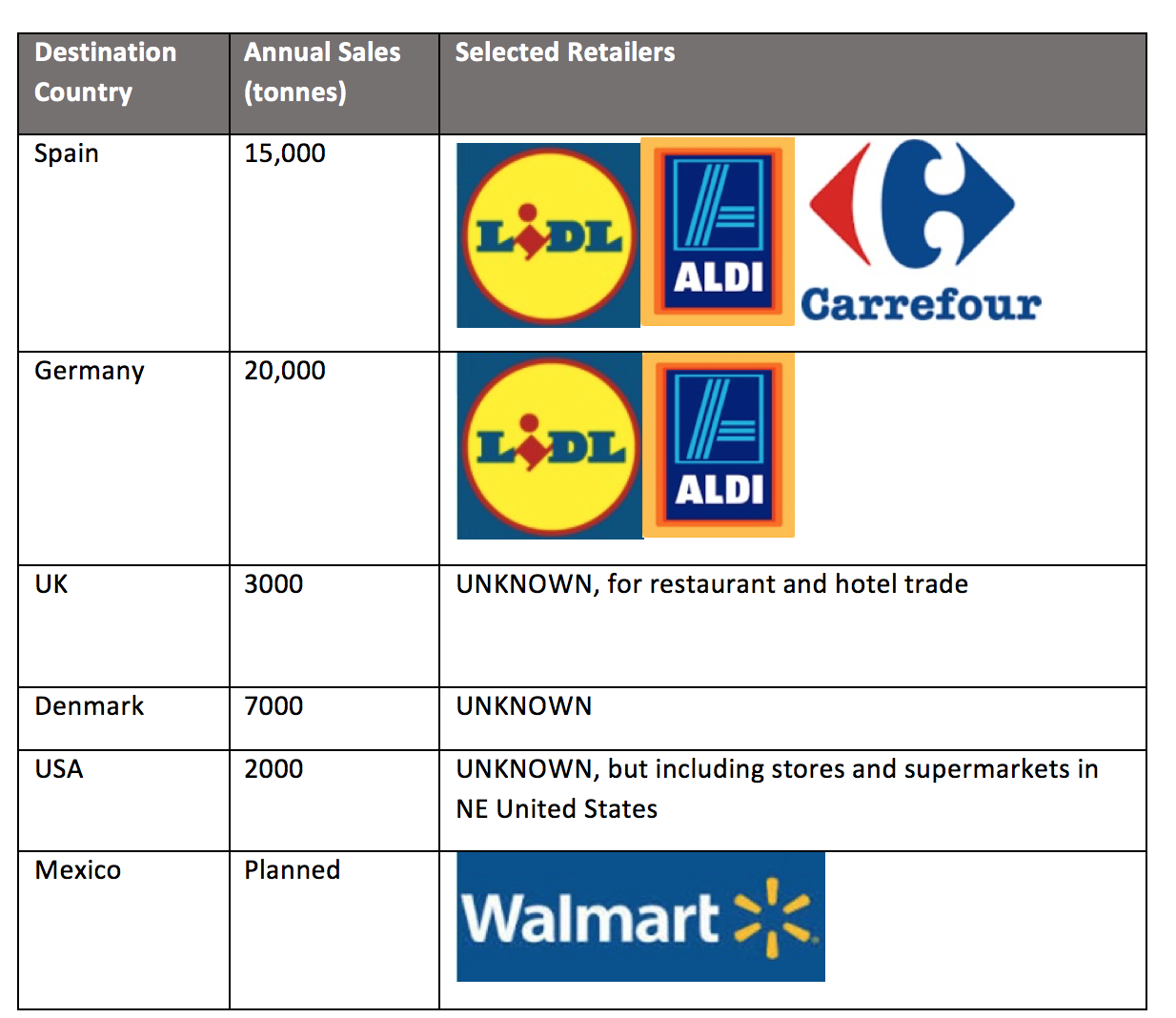
Sales to Spain, Germany, UK and Denmark claimed by Ibecosol CEO. US Figure from Paraguay export records. Lidl Spain and Aldi Nord sales confirmed by companies. Sales in Lidl Germany and Aldi Nord in Spain claimed by Ibecosol CEO.
False sustainability claims
In its public statements and in private interviews with Earthsight investigators, Ibecosol makes numerous and conflicting claims regarding the sustainability of its charcoal production. That the products are not made from trees; they are from “reforestation”; they are made from pruning; they are “recycled”; and that they are independently certified as “sustainable”. These claims are mostly false and at best misleading.The website for the CARCOA brand, Ibecosol’s charcoal product in Spain and Portugal, claims that all of its products “are produced using wood from reforestation, pruning or selecting non-forest (shrub) species”.[85] In his meeting with Earthsight’s undercover investigator, Ibecosol’s CEO further stated that “we are not using trees, we are not cutting down trees to make briquettes or other products.”[86] These claims are clearly contradicted by Earthsight’s observations at Bricapar’s Teniente Ochoa production facility, where large trunks of quebracho blanco trees were observed stacked around the kilns (see Figure 18), by the testimony of the manager of that site, by government permits governing the deforestation and charcoal production on that land, and by Bricapar’s own statements to Earthsight.
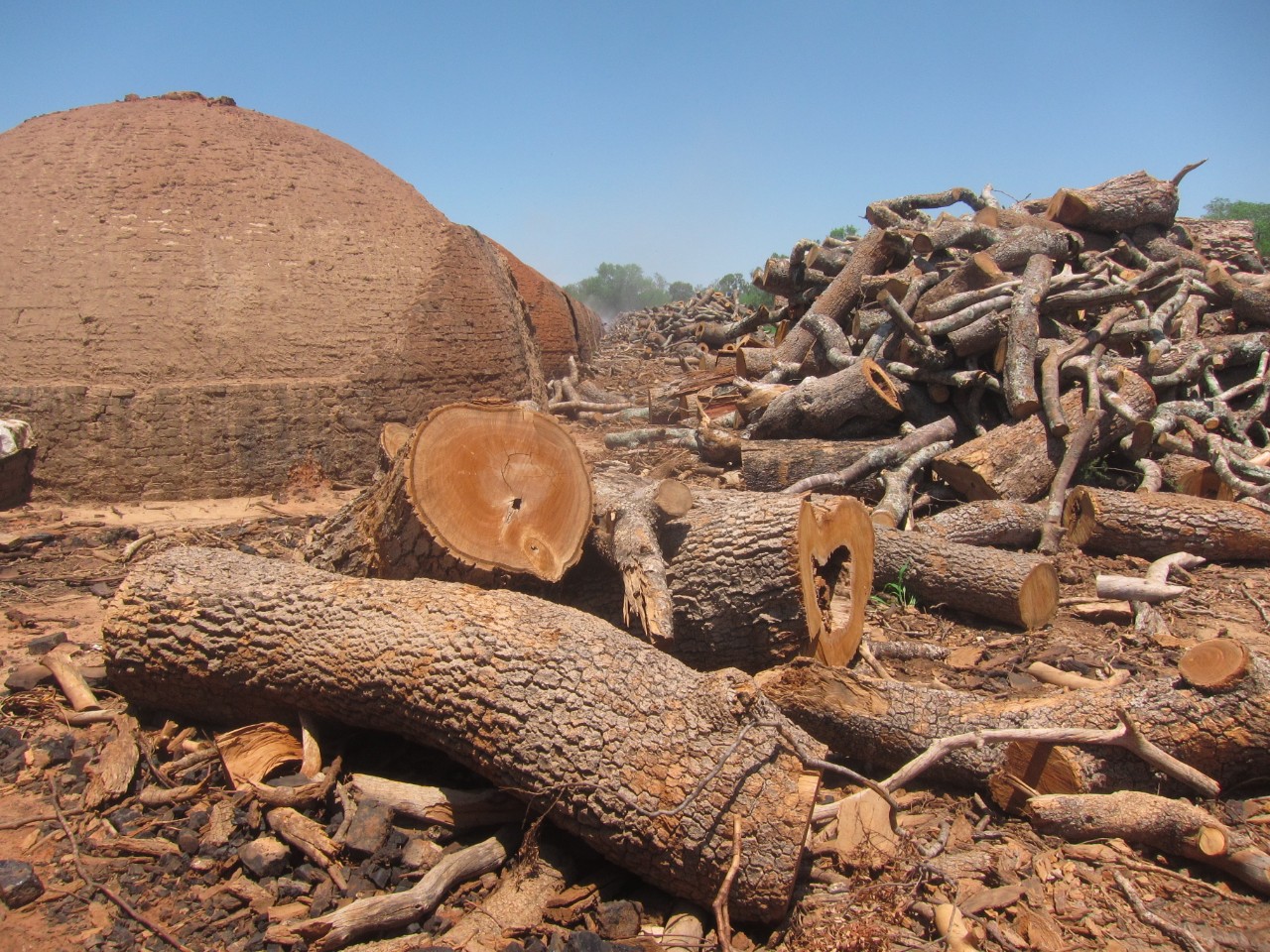
Quebracho tree trunks and branches waiting to be converted into charcoal at Bricapar’s facility at Teniente Ochoa, November 2016.
Ibecosol’s more serious sustainability claims relate to the
sustainability certificates the company holds.
The company has obtained ‘chain of custody’ certificates
from the two leading independent international organisations for certifying the
sustainability of wood products, the Forest Stewardship Council (FSC) and
Programme for the Endorsement of Forest Certification (PEFC). On its website,
Ibecosol claims that the FSC certificate “guarantees the wood used to
manufacture many [sic] of our lump charcoal comes from sustainable forests”.[87] However,
the truth is that this certificate does nothing of the sort. FSC “Chain of
Custody” (CoC) certification only means that a company has the right to handle
wood products separately certified as sustainably produced under an FSC ‘Forest
Management’ certificate. In fact, none of Bricapar’s production in Paraguay
comes from FSC certified sources. The claims regarding its FSC certificate made
on its website by Ibecosol are false, and would appear to be in clear breach of
FSC’s trademark rules.[88]
It is notable that in the responses Earthsight received from
supermarkets in Europe stocking Ibecosol’s Paraguayan charcoal — responses
which had clearly been informed by information supplied by Ibecosol — no
mention is made of any of the above claims. Instead, they focus on Ibecosol’s
PEFC certification. This certification appears to have been important in
maintaining these supermarkets’ custom: Seoane told Earthsight’s undercover
investigator that these chains are increasingly demanding assurances about the
environmental impact of his products.
In Earthsight’s meeting with Ibecosol’s CEO, he claimed that
the wood used is “recycled” and that the PEFC certificate was proof that all of
the company’s charcoal was from recycled wood and not from cutting down trees.
It is true that both Bricapar and Ibecosol hold PEFC CoC certificates issued in
October 2016 and January 2017 respectively.[89] However,
there are a couple of major issues with these certificates.
Firstly, the certificates only apply to the company’s
charcoal briquettes — not to its lumpwood charcoal.[90] Despite
this, Bricapar and Ibecosol have been falsely using their PEFC status to
reassure European retailers of their lumpwood charcoal. Lidl Spain, which sells
Ibecosol’s lumpwood charcoal, told Earthsight that Ibecosol’s PEFC
certification “confirmed” the sustainable origin of the raw materials. Yet as
far as the lumpwood product is concerned, the PEFC certificate is meaningless.
Secondly, while PEFC has certified the briquette products as
‘recycled’, their flawed definitions do not prevent products made from trees
felled during conversion of valuable chaco forest into cattle pasture from
entering supply chains. Bricapar (and its third party suppliers of charcoal
fines) are burning such trees to make charcoal, which comes in various sizes.
The smallest sizes — charcoal dust — are then used to make briquettes. If they
understood the production process fully, it seems unlikely that the
supermarkets buying these products or their customers would be persuaded by
PEFC and Bricapar’s argument that these products qualify as ‘recycled’. The
fine charcoal dust is one of the products produced, and the fact that the
company is able to profitably turn it into a briquette means it cannot be
considered to be ‘waste’. By these definitions, sausages would count as
‘recycled’.
Applying PEFC standards, sausages would count as ‘recycled’
Because it classifies the raw material as ‘recycled’, PEFC
admits that it does not know or care where it actually originates.[91] Yet
PEFC itself classifies “conversion of forest to other vegetation type” as a
‘controversial source’[92]:
exactly the kind of thing which certification is supposed to preclude.
The extent to which PEFC certification can be relied on to
guarantee sustainability has also been questioned more broadly. In January
2017, TV station France2 broadcast a documentary on the global timber sector.
As part of the investigation, journalists mailed in official requests for a series
of absurd locations to be certified by PEFC. Most of their submissions were
apparently approved by mail with no questions asked — sites including a pig
farm, nuclear power plant, an airport and a supermarket parking lot.[93]
Prior to publication Earthsight provided both Bricapar, its
owner, and Ibecosol with a summary of our findings and asked for their
response. A law firm responding on behalf of Ibecosol said that the allegations
were “completely false”[94] but
declined to provide any evidence to substantiate the response or provide any
specific response regarding the sustainability claims.
In response to the allegation that it produces charcoal from natural forests, Bricapar responded that it “optimizes wood rolls and its residues that come from the legal use of forests”. The company also stated that during its harvesting activities at the IRASA land at Teniente Ochoa, it complies with local regulations which require 25 percent of the total leased area to be reserved as forest, plus 100 metre-wide strips around each authorised plot, within which 30 per cent of standing trees are also retained.[95]
Conclusion
The problems highlighted in this report go beyond the specific case study on which it focuses. Bricapar is not the only company producing charcoal in the Chaco for export, and there are no doubt many other European and US companies selling Chaco charcoal which Earthsight has yet to identify. There are also serious concerns relating to many of the other countries from which Europe imports charcoal.More than two-thirds of the EU’s charcoal consumption is
imported[96],
and WWF has estimated that around 20 per cent of that comes from illegal
logging.[97] Other
major exporters of charcoal to the EU include Nigeria, Namibia and Ukraine, all
of which are high-risk source countries where illegality and corruption are
widespread in the forest sector.
Europe’s complicity in the destruction of the Chaco also
goes beyond charcoal. While charcoal production is an important contributor,
the primary driver behind that destruction is industrial-scale beef production.
In 2016, EU countries imported €32 million of beef and €56 million of leather
from Paraguay. EU imports of beef from Paraguay trebled in 2016[98],
and now represent 10 percent of Paraguay’s total exports.[99] Given
its importance to cattle ranching in the country, it is almost certain that a
large percentage of these exports will be of cows reared on Chaco forest land
cleared for pasture.
If European consumers are to be sure they are not
unwittingly contributing to the loss of the precious Chaco, it will require
action by both the major supermarkets and the European Union.
The supermarkets must investigate more thoroughly the source
of relevant products such as charcoal and beef, and be more sceptical of
sustainability claims made by suppliers. They must join the long list of other
major consumer goods firms which have committed to eliminate sales of products
which are connected to deforestation.[100]
Though action by the larger supermarkets is essential, that
alone cannot prevent such products being sold elsewhere. Only governments can
do that. The European Union has already committed to taking action to prevent
its imports contributing to deforestation overseas, but is still considering
its options.[101] The
European Parliament recently passed a resolution on the issue, supporting
strong measures.[102] The
EU already has some relevant legislation relating to wood products, but it does
not include charcoal.[103] It
is essential that the EU acts swiftly to close that loophole and to implement
the broader actions covering beef and other commodities.
The Chaco doesn’t have much time left.
***
Choice Cuts received high-profile media coverage in key European markets, prompted a petition with more than 120,000 signatures, and sparked fresh attention to the crisis within Paraguay. You can read coverage of the report in The Guardian, The Times, Zeit Online, Open Democracy, Lamarea and Procesco.
As a result of our findings, the supermarket Carrefour has suspended sales while Lidl and Aldi have committed to investigate. The PEFC, a certification organisation whose scheme was used in a comical attempt to greenwash the role of the charcoal trade in this global environmental crisis, is also investigating. Two months after the launch of our investigation, and once our findings had been widely reported in the Paraguayan media, a congressional committee launched an investigation into deforestation in the Chaco, ordering the environment ministry to release documentation on permits and prosecutions. In January 2018, six months after the launch of our investigation, the PEFC decided to strip the Paraguayan charcoal exporter, Bricapar, of it's sustainability certification.
References:
[1] From Zoo Quest in Paraguay, a BBC programme aired in 1959 http://www.bbc.co.uk/programmes/p00dgmg9[2] http://wwf.panda.org/what_we_do/footprint/agriculture/soy/soyreport/soy_and_deforestation/the_gran_chaco/
[3] IWGIA
report: The Case of the Ayoreo, 2010 http://www.iwgia.org/iwgia_files_publications_files/The_case_of_the_ayoreo.pdf
[4] The
Soy Mirage, Oxfam, 2013 http://policy-practice.oxfam.org.uk/publications/the-soy-mirage-the-limits-of-corporate-social-responsibility-the-case-of-the-co-299687
[5] ibid
[6] WWF,
Atlantic Forests http://wwf.panda.org/about_our_earth/ecoregions/atlantic_forests.cfm
[7] WWF,
Paraguay extends zero deforestation law to 2018 http://wwf.panda.org/?210224/Paraguay-extends-Zero-Deforestation-Law-to-2018
[8] Going
green: the tragic dofersation of the Chaco, Rolling Stone, 2014 http://www.rollingstone.com/culture/news/green-going-gone-the-tragic-deforestation-of-the-chaco-20140728
[9] Global
Forest Watch, Paraguay http://www.globalforestwatch.org/country/PRY
[10] ibid
[11] Hansen,
M. et al., 2013. High-Resolution Global Maps of 21st Century Forest Cover
Change, Science Vol 342 pp850–853. Analysis of supplementary data shows that
the majority of the Chaco forest loss occurred in Paraguay.
[12] Calculated
by Earthsight from supplementary data in Hansen (2013), using data for forest
extent and loss of canopy cover greater than 25%
[13] Guyra
monthly Gran Chaco deforestation monitoring reports http://guyra.org.py/informe-deforestacion/
[14] Guyra
monthly reports 2017 http://guyra.org.py/informe-deforestacion-2017/
[15] Disappearing
World: Paraguay’s Ayoreo people fight devastating land sales, The Guardian,
2016 https://www.theguardian.com/global-development/2016/jan/25/paraguay-ayoreo-people-chaco-fighting-back-land-sales
[16] UN
COMTRADE data, 2016, ranked by weight
[17] Racing
against time to save the tagua and its vanishing Chaco home, MongaBay,
2017 https://news.mongabay.com/2017/01/racing-against-time-to-save-the-tagua-and-its-vanishing-chaco-home/
[18] Sustainable
forest management in the transboundary Gran Chaco Americano Ecosystem, OAS
Department of Sustainable Development http://www.oas.org/dsd/waterresources/projects/Chaco_eng.asp
[19] Gran
Chaco, Encyclopaedia Britannica https://www.britannica.com/place/Gran-Chaco
[20] Calculated
by Earthsight using map from The Case of the Ayoreo’, Union de Nativos Ayoreo
de Paraguay / Iniciativa Amotocodie, 2010 — http://www.iwgia.org/iwgia_files_publications_files/The_case_of_the_ayoreo.pdf
[21] UN
Special Rapporteur on the Rights of Indigenous Peoples, The situation of
indigenous peoples in Paraguay, http://unsr.vtaulicorpuz.org/site/index.php/documents/country-reports/84-report-paraguay
[22] Interamerican
Court of Human Rights, Prelimenary Resolution PM 54/13 — Matter of communities
in voluntary isolation of the Ayoreo Totobiegosode People, Paraguay — http://www.oas.org/es/cidh/decisiones/pdf/2016/MC54-13-Es.pdf
[23] UN
Special Rapporteur on the Rights of Indigenous Peoples, The situation of
indigenous peoples in Paraguay, http://unsr.vtaulicorpuz.org/site/index.php/documents/country-reports/84-report-paraguay
[24] This
refers in particular to the case of the Ayoreo Totobiegosode, which has been
repeatedly denounced by the Special Rapporteur
[25] Resolucion
de la corte interamericana de derechos humanos, Casos de las comunidades
indígenas Yakye Axa, Sawhoyamaxa y Xakmok Kasek vs. Paraguay, 2015 http://www.corteidh.or.cr/docs/supervisiones/yakie_24_06_15.pdf
[26] UN
COMTRADE data for Paraguay exports, by weight
[27] Paraguay
export records, Jan-Apr 2017
[28] Eurostat
EU import records, Jan-Mar 2017. Based on typical 5kg consumer charcoal bag.
The UK reported 2100 tonnes and Germany 10,100 tonnes
[29] Eurostat
import data 2016
[30] Estimated
from 2016 annual Eurostat import data by weight in tonnes, and a rate of 7.5
tonnes of charcoal production per hectare, the production yield for the IRASA
land at Teniente Ochoa, according to the relevant INFONA permit from 2014.
Estimate assumes that all Paraguayan charcoal exports are sourced from forest
clearance in the Chaco. Available studies suggest that this is true of the
majority. Annual total divided by 365 days to obtain daily average, and by 1.6
football pitches per hectare, based on standard international football pitch
dimensions.
[31] Dolimex
homepage, http://dolimex.com/carbon-vegetal.php?lang=en
[32] http://dolimex.com/carbon-vegetal.php,
accessed 4th July 2017
[33] Letter
to Earthsight from Miller Sands solicitors on behalf of Big K, 16th June 2017
[34] Email
to Earthsight from Miller Sands solicitors on behalf of Big K, 30th June 2017
[35] Jealous
Devil homepage, http://jealousdevil.com/
[36] DemocraciaAbierta,
‘Rural Paraguayans fight for land amid corruption, poverty and violence’, 9th
May 2016 — https://www.opendemocracy.net/democraciaabierta/toby-hill/rural-paraguayans-fight-for-land-amid-corruption-poverty-and-violence
[37] Mercosur
suspends Paraguay over Lugo impeachment, BBC, 2012 http://www.bbc.co.uk/news/world-latin-america-18636201
[38] Horacio
Cartes wins Paraguay Election, The Guardian, 2013 https://www.theguardian.com/world/2013/apr/22/horacio-cartes-wins-paraguay-election
[39] Fiscalia
investiga Jimenez Gaona por lesion y asociacion criminal, ABC Color, 2017 http://www.abc.com.py/edicion-impresa/economia/fiscalia-investiga-a-jimenez-gaona-por-lesion-y-asociacion-criminal-1602187.html
[40] Pujol
Junior cobró comisiones del 10% por concursos amanados en Africa, El Mundo,
2017 http://www.elmundo.es/espana/2017/05/20/591f52ede5fdead4708b457c.html
[41] Ibid
[42] Fiscal
que investiga a ministro por lesion pidio documentos de viaducto, ABC Color,
2017 http://www.abc.com.py/edicion-impresa/economia/fiscal-que-investiga-a-ministro-por-lesion-pidio-documentos-de-viaducto-1602478.html
[43] Jimenez
Gaona niega coima y anuncia demanda contra abc, ABC Color, 2017 http://www.abc.com.py/edicion-impresa/politica/jimenez-gaona-niega-coima-y-anuncia-demanda-contra-abc-1596232.html
[44] Calculated
from export figures broken down by supplier sourced from Export and Investment
Network of the Paraguayan Ministry of Industry and Commerce
[45] ibid
[46] Paraguay
export data, Jan-April 2017
[47] Privelegiada
ubicacion de tierras del ips aluiladas a precios irrisorios, ABC Color,
2017 http://www.abc.com.py/edicion-impresa/economia/privilegiada-ubicacion-de-tierras-del-ips-alquiladas-a-precios-irrisorios-1254195.html
[48] Summary
of rental contracts of IPS land in Teniente Ochoa seen by Earthsight
[49] Resolucion
INFONA No 1266/2009
[50] Letter
from Bricapar to Earthsight 15 June 2017
[51] Potapov,
P. et al., 2017, ‘The last frontiers of wilderness: Tracking loss of intact
forest landscapes from 2000 to 2013’, Science Advances, 2017
[52] USAID,
Report on Biodiversity and Tropical Forests in Paraguay, 2010, https://www.usaid.gov/sites/default/files/documents/1862/paraguay_biodiversity_tropical_forest_report.pdf
[53] Landsat
8 satellite images, analysed by Earthsight, show 510 hectares of conversion
(not including roads) in 2010, 860 hectares in 2011, 784 hectares in 2012 and
1765 hectares in 2013.
[54] ABC
Color, ‘Hay una explotación racional de bosques en tierras del IPS, afirman’,
29th Oct 2014 — http://www.abc.com.py/edicion-impresa/politica/hay-una-explotacion-racional-de-bosques-en-tierras-del-ips-afirman-1300648.html
[55] Clearance
of vegetation within such plots is classified as ‘forest loss’ by the
University of Maryland/WRI — see www.globalforestwatch.org.
Data from the University of Maryland indicate that dry chaco forests in the
area have a canopy cover of between 30 and 50 per cent, thus meeting
internationally agreed definitions of ‘forest’. The blocks converted to cattle
pasture have a canopy cover of less than 10 per cent, and do not classify as
forest.
[56] Production
capacity as of November 2016 according to information provided to undercover
Earthsight investigators by the manager of the facility, November 2016
[57] Comparison
with Paraguay export data, taking into account planned expansion of Teniente
Ochoa facility to 100 ovens from 80
[58] Earthsight
undercover recording 30 November 2016
[59] See
ABC Color, ‘Privelegiada ubicacion de tierras del ips aluiladas a precios
irrisorios’, 11th June 2014, and other articles in the same series
[60] ABC
Color, “Infona y Seam aprobaron los masivos desmontes”, 27th October 2014
[61] Reconstruiran
caminos en el Chaco, ABC Color, 2013 http://www.abc.com.py/nacionales/reconstruiran-caminos-en-el-chaco-1434603.html
[62] Letter
to Earthsight from Bricapar, 15th June 2017
[63] Solventa
investment report on Bricapar, December 2015
[64] Distances
calculated by overlaying boundary of IRASA land with map from ‘The Case of the
Ayoreo’, Union de Nativos Ayoreo de Paraguay / Iniciativa Amotocodie, 2010
— http://www.iwgia.org/iwgia_files_publications_files/The_case_of_the_ayoreo.pdf
[65] Letter
to Earthsight from Bricapar, 15th June 2017
[66] Paraguay
export records, Jan-Apr 2017
[67] Paraguay
export shipment records Jan-Apr 2017 confirm that Bricapar was the largest
Paraguayan charcoal exporter to the UK. There were no direct exports by
Bricapar to Germany recorded, but our interview with Bricapar’s sister company
Ibecosol in Spain confirmed that 90% of Bricapar’s imports into Spain are
destined for onward shipment to Germany; Eurostat customs records support this.
Once these shipments are taken into account, Bricapar comes out as the top
Paraguayan supplier there too.
[69] Interview
with Guillermo Vega de Seaone, 2013 https://www.youtube.com/watch?v=6802hfQSjdA
[70] Solventa
investment report, December 2015 —
solventa.com.py/wp-content/uploads/2015/12/Informe-PEG-USD1-BRICAPAR-SET2015-VFinal.pdf
[71] Interview
with Guillermo Vega de Seaone, 2013 https://www.youtube.com/watch?v=6802hfQSjdA
[72] Interview
with Guillermo Vega de Seaone by Earthsight undercover investigator, May 2017
[73] Paraguay
export records, Jan-Apr 2017
[74] Interview
with Guillermo Vega de Seaone by Earthsight undercover investigator, May 2017
[75] https://www.amazon.co.uk/s/ref=nb_sb_noss?url=search-alias%3Daps&field-keywords=Carcoa+charcoal
[76] Paraguay
export records, Jan-Dec 2016
[77] Paraguay
export data record 2115 tonnes of charcoal exported by Bricapar to
un-identified buyers in the USA during 2016. Of this total, 1950 tonnes could
be identified on US PIERS import records, of which 1324 tonnes was destined for
Duraflame.
[78] US
PIERS import records
[79] Ibid.
[80] Earthsight
telephone call with Chris Caron of Duraflame, 26th June 2017
[81] Email
to Earthsight from Matias Bueno of Lidl Supermercados SAU, 15th June 2017
[82] Letter
to Earthsight from Dr Julia Adou and Simon Binder of Aldi Sud
Dienstleistungs-GmbH & Co. oHG, 19th June 2017
[83] Email
to Earthsight from Verena Lissek, Press Department, ALDI Einkauf GmbH & Co.
oHG, 19th June 2017
[84] Email
to Earthsight from Agathe Grossmith, Carrefour Global, 29th June 2017
[85] Carbon
Carcoa, Un Carbon Sostenbile
carboncarcoa.com/aire-libre/carcoa-un-carbon-sostenible/
[86] Interview
with Guillermo Vega de Seaone by Earthsight undercover investigator, May 2017
[87] Carbon
Carcoa, Un Carbon Sostenbile
carboncarcoa.com/aire-libre/carcoa-un-carbon-sostenible/
[88] Section
7.1 of the FSC’s trademark rules states that if a company has not sold
any FSC certified products since its most recent annual audit it must not use
the FSC trademarks for general promotion. Ibecosol’s website carries the FSC
logo, and its last audit was in August 2016.
[89] PEFC
website. Bricapar certificate (issued by SGS) — https://www.pefc.org/company-detail?id=818113 ;
Ibecosol certificate (issued by NEPcon)- https://www.pefc.org/company-detail?id=819302
[90] As
per the product scope described in the summary on the PEFC website — https://www.pefc.org/company-detail?id=818113 —
and confirmed to Earthsight in direct communication from PEFC, 4th July 2017
[91] PEFC,
‘Statement about the PEFC certification of Bricapar’, email communication to
Earthsight, 4th July 2017
[92] See
section 3.9(d) of PEFC ST 2002:2013, Chain of Custody of Forest Based Products
— Requirements. Second Edition, 7th December 2015 — http://pefc.org/images/documents/standards/PEFC_ST_2002-2013_CoC_Standard_-_Second_Edition.pdf
[93] France2,
‘Cash Investigation — Razzia sur le bois, les promesses en kit des géants du
meuble / intégrale’, 25th January 2017 — https://www.youtube.com/watch?v=KJgwaDeSgN4&t=3909s
[94] Letter
to Earthsight from Ibecosol, 15th June 2017
[95] Letter
to Earthsight from Bricapar, 15th June 2017
[96] TFT, Charcoal Research, February 2015
[97] WWF,
‘Illegal wood for the European market: An analysis of the EU
import and export of illegal wood and related products’, July 2008
[98] Eurostat
import data 2016
[99] UN
COMTRADE data 2016
[100] See
for example, the New York Declaration on Forests, http://forestdeclaration.org,
and the summary of such commitments maintained by Forest Trends http://supply-change.org
[101] http://www.bad-ag.info/eu-deforestation-conference-considers-action-on-bad-ag-2/
[102] http://www.bad-ag.info/parliament-resolves-to-tackle-eus-role-in-driving-illegal-deforestation-through-imports-of-agro-commodities/
[103] The EU Timber Regulation, which took effect in 2013, prohibits the import of timber and wood products which were illegally sourced in the country of origin, and requires importers to carry out due diligence to minimise the risk of handling such goods. The regulation covers most categories of wood products, from firewood to fibreboard and paper to furniture, but a small number of products were excluded from the scope, including charcoal.
